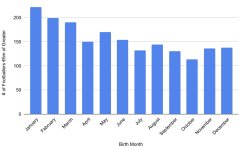AlbionInUs
Active member
Today, Brighton & Hove Albion have signed Enock Mwepu, Zambian midfielder from RB Salzburg. One of the things that immediately stood out to me was his birthday; January 1st. January 1st is perhaps the most popular amongst professional athletes, and is regarded as the best birthday for athletes. Other players in the Brighton squad born on January 1st include Shane Duffy.
But why? January 1st is the most commonly used cut off date for youth international sporting competitions. AFC, CAF, CONCACAF, CONMEBOL, OFC and UEFA all use 1 January as their cut-off date when determining an athlete's eligibility in youth competitions. A difference in just a couple of months can make a huge difference in player performance. Players that are a couple of months younger are more often lacking in the physical and mental strength of their older peers. They also had less time to develop as a player. As a result of being perceived as “inferior”, these players will receive a lower quality of coaching, and therefore, are less likely to succeed.
I had a look at the transfermarkt to see how much of an impact the Relative Age Effect actually had. In the chart below, I sorted players worth €5m and above by the month they were born:

As you can see, there is a clear correlation between birth month and the success of a footballer. Most notably, 222 players born in January have a market value €5m or greater, whilst only 113 players born in October have a market value €5m or greater. So if you're looking to breed a champion, early April is the time to do it!
But why? January 1st is the most commonly used cut off date for youth international sporting competitions. AFC, CAF, CONCACAF, CONMEBOL, OFC and UEFA all use 1 January as their cut-off date when determining an athlete's eligibility in youth competitions. A difference in just a couple of months can make a huge difference in player performance. Players that are a couple of months younger are more often lacking in the physical and mental strength of their older peers. They also had less time to develop as a player. As a result of being perceived as “inferior”, these players will receive a lower quality of coaching, and therefore, are less likely to succeed.
I had a look at the transfermarkt to see how much of an impact the Relative Age Effect actually had. In the chart below, I sorted players worth €5m and above by the month they were born:

As you can see, there is a clear correlation between birth month and the success of a footballer. Most notably, 222 players born in January have a market value €5m or greater, whilst only 113 players born in October have a market value €5m or greater. So if you're looking to breed a champion, early April is the time to do it!
